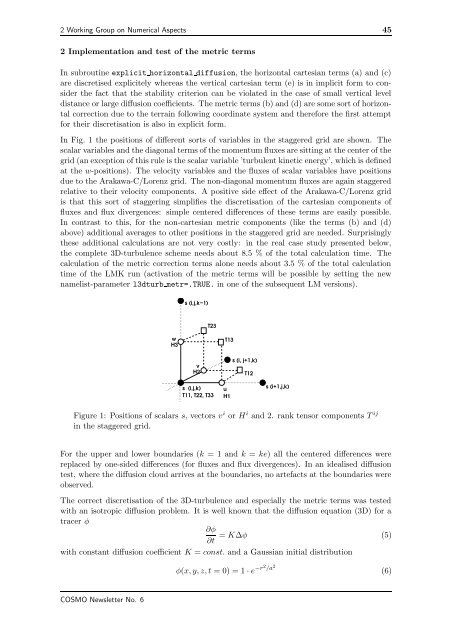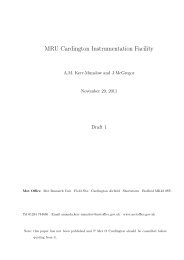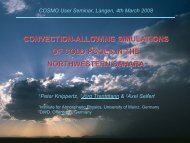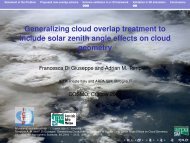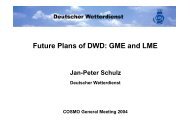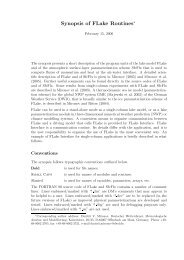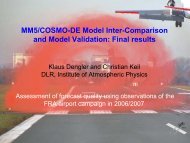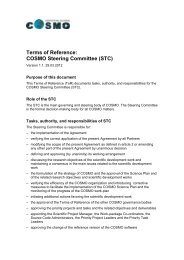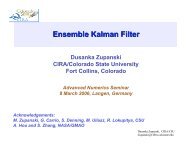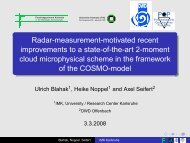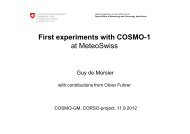document - Cosmo
document - Cosmo
document - Cosmo
Create successful ePaper yourself
Turn your PDF publications into a flip-book with our unique Google optimized e-Paper software.
2 Working Group on Numerical Aspects 45<br />
2 Implementation and test of the metric terms<br />
In subroutine explicit horizontal diffusion, the horizontal cartesian terms (a) and (c)<br />
are discretised explicitely whereas the vertical cartesian term (e) is in implicit form to consider<br />
the fact that the stability criterion can be violated in the case of small vertical level<br />
distance or large diffusion coefficients. The metric terms (b) and (d) are some sort of horizontal<br />
correction due to the terrain following coordinate system and therefore the first attempt<br />
for their discretisation is also in explicit form.<br />
In Fig. 1 the positions of different sorts of variables in the staggered grid are shown. The<br />
scalar variables and the diagonal terms of the momentum fluxes are sitting at the center of the<br />
grid (an exception of this rule is the scalar variable ’turbulent kinetic energy’, which is defined<br />
at the w-positions). The velocity variables and the fluxes of scalar variables have positions<br />
due to the Arakawa-C/Lorenz grid. The non-diagonal momentum fluxes are again staggered<br />
relative to their velocity components. A positive side effect of the Arakawa-C/Lorenz grid<br />
is that this sort of staggering simplifies the discretisation of the cartesian components of<br />
fluxes and flux divergences: simple centered differences of these terms are easily possible.<br />
In contrast to this, for the non-cartesian metric components (like the terms (b) and (d)<br />
above) additional averages to other positions in the staggered grid are needed. Surprisingly<br />
these additional calculations are not very costly: in the real case study presented below,<br />
the complete 3D-turbulence scheme needs about 8.5 % of the total calculation time. The<br />
calculation of the metric correction terms alone needs about 3.5 % of the total calculation<br />
time of the LMK run (activation of the metric terms will be possible by setting the new<br />
namelist-parameter l3dturb metr=.TRUE. in one of the subsequent LM versions).<br />
w<br />
H3<br />
s (i,j,k−1)<br />
v<br />
H2<br />
T23<br />
s (i,j,k)<br />
T11, T22, T33<br />
T13<br />
u<br />
H1<br />
s (i, j+1,k)<br />
T12<br />
s (i+1,j,k)<br />
Figure 1: Positions of scalars s, vectors v i or H i and 2. rank tensor components T ij<br />
in the staggered grid.<br />
For the upper and lower boundaries (k = 1 and k = ke) all the centered differences were<br />
replaced by one-sided differences (for fluxes and flux divergences). In an idealised diffusion<br />
test, where the diffusion cloud arrives at the boundaries, no artefacts at the boundaries were<br />
observed.<br />
The correct discretisation of the 3D-turbulence and especially the metric terms was tested<br />
with an isotropic diffusion problem. It is well known that the diffusion equation (3D) for a<br />
tracer φ<br />
∂φ<br />
= K∆φ (5)<br />
∂t<br />
with constant diffusion coefficient K = const. and a Gaussian initial distribution<br />
COSMO Newsletter No. 6<br />
φ(x, y, z, t = 0) = 1 · e −r2 /a 2<br />
(6)


